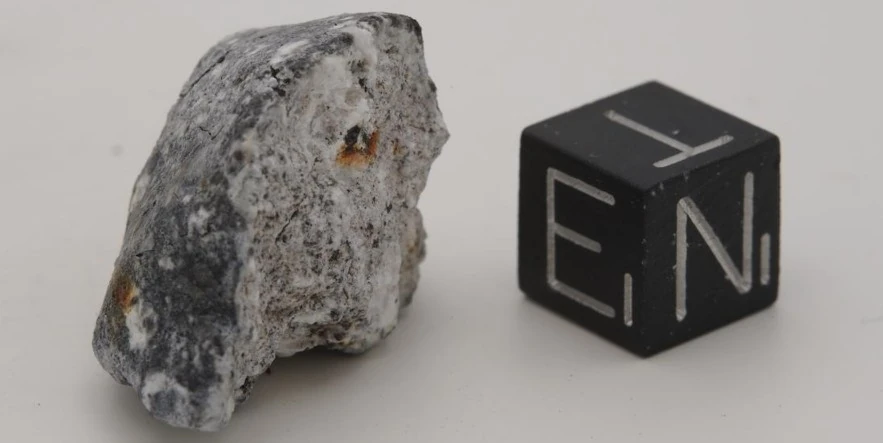Initial investigations of meteorites from the strewn field of asteroid 2024 BX1, which entered the Earth’s atmosphere on January 21, 2024, near Ribbeck, northwest of Berlin, have identified them as rare aubrite achondrites. The findings were submitted to the Meteoritical Society’s Nomenclature Committee on February 2, 2024, for official examination.
A recent breakthrough at the Museum für Naturkunde (MfN) Berlin has unveiled that meteorites collected from the asteroid 2024 BX1 are rare aubrites. This discovery came after the asteroid passed through Earth’s atmosphere near Ribbeck on January 21, 2024, marking a significant addition to the museum’s collection.
After the asteroid 2024 BX1 disintegrated in the Earth’s atmosphere, a collaborative effort led by the Museum für Naturkunde Berlin, with partners including the German Aerospace Center, Freie Universität Berlin, Technische Universität Berlin, and the SETI Institute in the USA, resulted in the collection of over 20 meteorite samples over the past couple of days.
The meteorites were identified as aubrite achondrites, a classification confirmed through detailed mineralogical and chemical analyses using the museum’s electron microprobe.

“Aubrites look more like a grayish granite and consist mainly of the magnesium silicates enstatite and forsterite,” says Dr. Christopher Hamann, who was involved in the meteorite’s initial classification and is with the museum’s Solar System, Impacts and Meteorites department. “It contains hardly any iron and the fusion crust, a thin, tell-tale layer of quenched melt coating meteorites and which typically allows identifying them as such in the field, looks completely different than that of most other meteorites. Aubrites are therefore difficult to detect in the field.”
Dr. Ansgar Greshake, the head of the museum’s Meteorite Collection, highlighted the value of scientific collections in facilitating rapid classification by comparing the Ribbeck samples to the first aubrite ever collected on Earth, which fell in Aubrés, France, in 1836. Currently, the museum plans to exhibit some of the Ribbeck meteorites, further emphasizing the importance of these findings to both the scientific community and the public.
Thanks to my wonderful colleague @allplanets I knew where and when to look for a #meteor coming down over #Berlin tonight. Here’s the video! pic.twitter.com/kBhGz6Ahir
— Michael Aye (@michaelaye@mastodon.online) 🇩🇪🇺🇦 (@michaelaye) January 21, 2024
Asteroid 2024 BX1 (temporary designation Sar2736) impacted Earth’s atmosphere near Berlin, Germany at 00:33 UTC on January 21, 2024.
The object had an estimated diameter between 0.7 and 1.6 m (2.23 – 5.2 feet) and was discovered about 150 minutes before impact by astronomer Krisztián Sárneczky at GINOP-KHK, Piszkesteto Station in Hungary.
This is the third discovery of Earth’s impactor made by Sárneczky. His previous discoveries were 2022 EB2 which impacted Earth’s atmosphere southwest of Jan Mayen island in the Arctic Ocean on March 21, 2022, and 2023 CX1 which impacted over the English Channel, between England and France on February 13, 2023.
Asteroid 2024 BX1 is only the 8th asteroid discovered before impacting Earth.
The other 7 asteroids detected before impact are:
- 2008 TC3 – impacted over the Nubian desert, Sudan on October 7, 2008. Discovered on October 6, 2008. Diameter: approximately 4 m (13 feet); Mass approximately 80 tons.
- 2014 AA – impacted over the Atlantic Ocean, 3 000 km (1 864 miles) from Caracas, Venezuela on January 2, 2014. Discovered on January 1, 2014. Diameter: approximately 3 m (9.8 feet); Mass approximately 40 tons.
- 2018 LA – impacted over the Botswana-South Africa border on June 2, 2018. Discovered on June 2, 2018. Diameter: approximately 3 m (9.8 feet); Mass approximately 40 tons.
- 2019 MO – impacted off the south coast of Puerto Rico, the Caribbean Sea on June 22, 2019. Discovered on June 22, 2019. Diameter: approximately 5 m (9.8 feet); Mass approximately 200 tons.
- 2022 EB5 – impacted southwest of Jan Mayen island in the Arctic Ocean at around 21:22 UTC on March 11, 2022. Discovered roughly two hours before impact. Diameter: approximately 3 m (9.8 feet).
- 2022 WJ1 – impacted over Niagara Falls at 08:27 UTC on November 19, 2022. Discovered at 04:53 UTC on November 19. Diameter between 0.5 and 1.2 m (1.6 – 3.9 feet).
- 2023 CX1 – impacted over the English Channel, between England and France at 02:59 UTC on February 13, 2024. Discovered about 3 hours before impact. Diameter between 0.8 to 1.8 m (2.6 to 5.9 feet).
References:
1 Meteor near Berlin classified as extremely rare Aubrite-type meteorite – Museum für Naturkunde – February 5, 2024
2 Asteroid 2024 BX1 (Sar2736) impacts Earth’s atmosphere over Berlin, Germany – the 8th predicted impact on record – The Watchers – January 21, 2024
Featured image credit: Museum für Naturkunde
If you value what we do here, create your ad-free account and support our journalism.
Bright fireball over Mumbai, India – the second in 5 days
Tuesday, February 6, 2024
Very bright fireball over downtown Beijing, China
Monday, January 29, 2024
Very bright fireball over Spain and Portugal
Monday, January 22, 2024
Very bright daylight fireball over France and Spain
Thursday, January 18, 2024
Meteorite fall over Sardinia, Italy — INAF calls for meteorite hunt
Friday, October 13, 2023
Very bright fireball explodes over Bariloche, Argentina
Sunday, September 10, 2023
Bright fireball over Andalusia, Spain
Sunday, September 10, 2023
